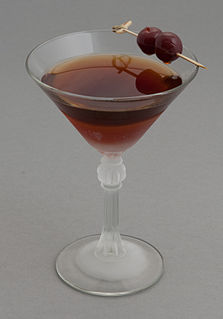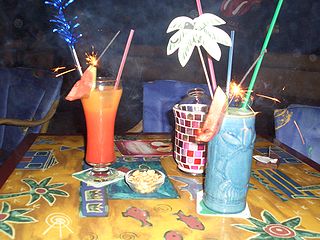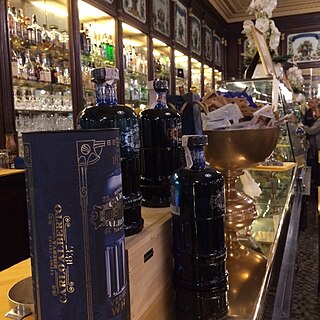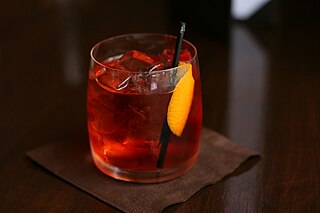
A gin and tonic is a highball cocktail made with gin and tonic water poured over ice. The ratio of gin to tonic varies according to taste, strength of the gin, other drink mixers being added, etc., with most recipes calling for between a 1:1 to 1:3 ratio. It is usually garnished with a slice or wedge of lime.

A Manhattan is a cocktail made with whisky, sweet vermouth and bitters. While rye is the traditional whiskey of choice, other commonly used whiskies include Canadian whisky, bourbon, blended whiskey and Tennessee whiskey. The cocktail is usually stirred then strained into a cocktail glass and garnished with a Maraschino cherry. A Manhattan may also be served on the rocks in a lowball glass.

The Rob Roy is a cocktail consisting primarily of whisky and vermouth, created in 1894 by a bartender at the Waldorf Astoria in Manhattan, New York City. The drink was named in honor of the premiere of Rob Roy, an operetta by composer Reginald De Koven and lyricist Harry B. Smith loosely based upon Scottish folk hero Rob Roy MacGregor.

A mixed drink is a beverage in which two or more ingredients are mixed. Some contain liquor, others are non-alcoholic. A "spirit and mixer" is any combination of one spirit with one non-alcoholic component, such as gin and tonic, whereas a "cocktail" generally comprises three or more ingredients.

A sour is a traditional family of mixed drinks. Common examples of sours are the margarita and the sidecar. Sours belong to one of the old families of original cocktails and are described by Jerry Thomas in his 1862 book How to Mix Drinks.

Angostura bitters is a concentrated bitters based on gentian, herbs and spices, by House of Angostura in Trinidad and Tobago. It is typically used for flavouring beverages or, less often, food. The bitters were first produced in the town of Angostura, hence the name, but do not contain angostura bark. The bottle is recognisable by its distinctive oversized label. 'Angostura' is Spanish for 'narrowing', the town of Angostura having been located at the first narrowing of the Orinoco River.
Dryness is a property of beverages that describes the lack of a sweet taste. This may be due to a lack of sugars, the presence of some other taste that masks sweetness, or an underabundance of simple carbohydrates that can be converted to sugar by enzymes in the mouth. The term "dry" may be applied to types of beer, wine, distilled spirits, or any other form of alcoholic beverage.
Flavored liquors are alcoholic beverages that have added flavoring and, in some cases, a small amount of added sugar. They are distinct from liqueurs in that liqueurs have a large sugar content and may also contain glycerine.

The Fine Art of Mixing Drinks is a book about cocktails by David A. Embury, first published in 1948. The book is noteworthy for its witty, highly opinionated and conversational tone, as well as its categorization of cocktails into two main types: aromatic and sour; its categorization of ingredients into three categories: the base, modifying agents, and special flavorings and coloring agents; and its 1:2:8 ratio for sour type cocktails.

Orange bitters is a form of bitters, a cocktail flavoring made from such ingredients as the peels of Seville oranges, cardamom, caraway seed, coriander, anise, and burnt sugar in an alcohol base. Orange bitters, which are not to be confused with standard Angostura aromatic bitters, are currently enjoying a resurgence among cocktail enthusiasts.

There are many cocktails made with cachaça, the national spirit of Brazil. Caipirinha is by far the most popular and internationally well-known.
The Martinez is a classic cocktail that is widely regarded as the direct precursor to the Martini. It serves as the basis for many modern cocktails, and several different versions of the original exist. These are generally distinguished by the accompaniment of either Maraschino or Curacao, as well as differences in gin or bitters.
A Parisian is a cocktail with dry vermouth, gin, and crème de cassis. Blackberries are a common garnish. The drink was created in the 1920s to promote crème de cassis.
A whiskey cocktail is a cocktail that includes whiskey. Although whiskey is often served neat or on the rocks, it is used in many classic cocktails such as the Old Fashioned, Manhattan, and Julep.
A bourbon whiskey cocktail is a cocktail that uses bourbon whiskey as an ingredient.
















